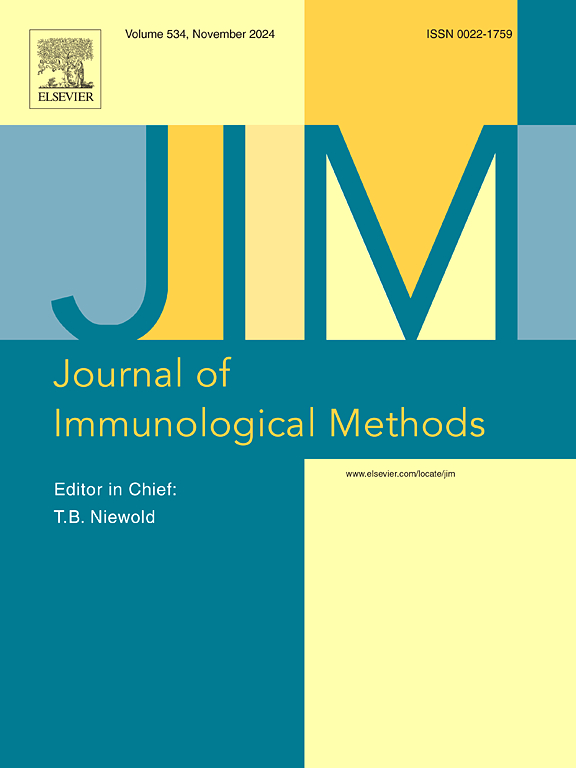Overcoming cross-reactivity of antibodies against human lactate dehydrogenase
IF 1.6
4区 医学
Q4 BIOCHEMICAL RESEARCH METHODS
引用次数: 0
Abstract
Lactate dehydrogenase subunit A (LD-A) plays an important role in cancer regulation and therapy. We attempted to develop an enzyme-linked immune-solvent assay (ELISA) for LD-A in human serum.
However, commercial antibodies against LD-A exhibited cross-reactivity with an unknown protein. The unknown protein was purified and characterized by protein sequencing and Western blotting. In addition, we attempted to prepare a specific antibody for the ELISA using partially synthesized peptides of LD-A as immunogens. The epitope position in LD-A was carefully selected based on bioinformatics analysis.
Peptide sequencer elucidated a ten amino acid sequence of the purified protein at the N-terminal. A BLAST search revealed that this sequence perfectly matched that at the N-terminus of the IgG heavy chain (H-chain). Furthermore, we demonstrated that twelve commercially available antibodies targeting LD-A or LD-B (subunit B) primarily cross-reacted with IgG or its H-chain, with only one specific antibody for each subunit. As the specific antibody against LD-A is no longer commercially accessible, we successfully produced two kinds of specific antibodies using partially synthesized LD-A peptides as immunogens.
In conclusion, we have successfully produced specific antibodies against LD-A. Moreover, our findings underscore the utility of bioinformatics tools for determining the optimal positions of immunizing peptides.

克服抗人乳酸脱氢酶抗体的交叉反应性。
乳酸脱氢酶亚基A (LD-A)在肿瘤调控和治疗中起着重要作用。我们试图建立人血清中LD-A的酶联免疫溶剂测定法(ELISA)。然而,针对LD-A的商业抗体显示出与未知蛋白的交叉反应性。通过蛋白测序和Western blotting对未知蛋白进行纯化和鉴定。此外,我们试图用部分合成的LD-A肽作为免疫原制备ELISA特异性抗体。根据生物信息学分析,精心选择LD-A的表位位置。肽段测序仪在n端鉴定了纯化蛋白的10个氨基酸序列。BLAST搜索结果显示,该序列与IgG重链(h链)n端完全匹配。此外,我们证明了12种针对LD-A或LD-B(亚基B)的市售抗体主要与IgG或其h链交叉反应,每个亚基只有一个特异性抗体。由于针对LD-A的特异性抗体已无法在市场上获得,我们成功地利用部分合成的LD-A肽作为免疫原制备了两种特异性抗体。总之,我们已经成功制备了针对LD-A的特异性抗体。此外,我们的研究结果强调了生物信息学工具在确定免疫肽的最佳位置方面的实用性。
本文章由计算机程序翻译,如有差异,请以英文原文为准。
求助全文
约1分钟内获得全文
求助全文
来源期刊
CiteScore
4.10
自引率
0.00%
发文量
120
审稿时长
3 months
期刊介绍:
The Journal of Immunological Methods is devoted to covering techniques for: (1) Quantitating and detecting antibodies and/or antigens. (2) Purifying immunoglobulins, lymphokines and other molecules of the immune system. (3) Isolating antigens and other substances important in immunological processes. (4) Labelling antigens and antibodies. (5) Localizing antigens and/or antibodies in tissues and cells. (6) Detecting, and fractionating immunocompetent cells. (7) Assaying for cellular immunity. (8) Documenting cell-cell interactions. (9) Initiating immunity and unresponsiveness. (10) Transplanting tissues. (11) Studying items closely related to immunity such as complement, reticuloendothelial system and others. (12) Molecular techniques for studying immune cells and their receptors. (13) Imaging of the immune system. (14) Methods for production or their fragments in eukaryotic and prokaryotic cells.
In addition the journal will publish articles on novel methods for analysing the organization, structure and expression of genes for immunologically important molecules such as immunoglobulins, T cell receptors and accessory molecules involved in antigen recognition, processing and presentation. Submitted full length manuscripts should describe new methods of broad applicability to immunology and not simply the application of an established method to a particular substance - although papers describing such applications may be considered for publication as a short Technical Note. Review articles will also be published by the Journal of Immunological Methods. In general these manuscripts are by solicitation however anyone interested in submitting a review can contact the Reviews Editor and provide an outline of the proposed review.

 求助内容:
求助内容: 应助结果提醒方式:
应助结果提醒方式:


